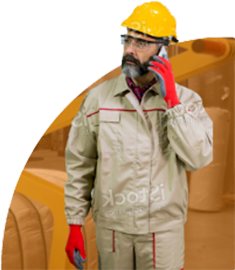Before using load chains, you need to make sure you are allowed to use them.
- The weight of the load must not exceed the load capacity of the load chains.
- Plan the securing of the load with the load chains before lifting or by lowering the load.
- The load capacity of the load chains corresponds to the attached table. Be sure to consider the angle of inclination when lifting. If you are unsure of the safety of lifting despite following the instructions, use stronger load chains or consult the manufacturer.
- If you use several load chains for lifting, you must fasten them under inclination angle up to ß = 60 °.
1. Stirrup load
2. Horizontal force component
3. Load 10 t
- The load chains must be secured so that the weight of the load is distributed over the entire width.
- The load must not be placed on the load chain.
- The load chains must be secured so that the weight of the load is distributed over the entire width.
- When lifting, the center of gravity of the load must be taken into account to prevent sudden twists and slips of the load.
- In the event that we are lifting the load in the tightening mode, the load must be pre-wrapped to prevent the load from slipping.
- Load chains must not be knotted (they must not have knots).
- When using larger load chains, all load chains must have the same load capacity.
- The safety factor of the load chains is 4 times higher than stated on the identification plate.
- Avoid vibrations or sudden movements.
- If you are towing a load on the ground, the load chain must not be under the load.
- When loading with sharp edges (the radius at the edge is smaller than the diameter of the load chain), the load capacity is reduced, so you have to protect the risk area with linings and edge guards before using load chains.
- Shorten the chain only by using shortening links.
- When fastening endless load chains, observe the minimum fastening radius, which must exceed 5 times the diameter of the chain link.
- Never strike the load chain to place it in the correct lifting position.
- Always fasten the load in the middle of the hook so that the hook or the hanging member can move freely.
- Hooks that are not in use during lifting must be attached to the suspension link.
- If you do not use all the stirrups for multi-strain load chains, they must be clamped in a suspension ring. The load capacity of the load chain is reduced by the value in the table.
- Replace damaged parts immediately.
- Observe the minimum distance from the lifted object until the load chains are released.
- Ensure the safety of personnel during lifting by determining their positions in the operating area or emptying the work area.
- When using load chains, make sure that the identification plate is not damaged.
- Do not reach into a dangerous lifting area with your hands or other limbs.
- After lifting, the load chains must be returned to a suitable warehouse.
- Do not store damaged chains together with usable chains.
